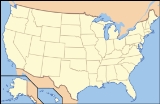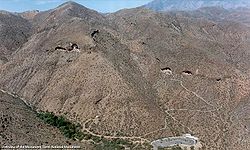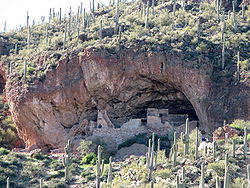
Tonto National Monument
Encyclopedia
Tonto National Monument is a National Monument
in central Arizona
, United States
. The area lies on the northeastern edge of the Sonoran Desert
, which is generally arid land with annual rainfall of about 16 inches (400 mm) here. The Salt River
runs through this area, providing a rare, year-round source of water.
 Well-preserved cliff dwellings were occupied by the Salado culture
Well-preserved cliff dwellings were occupied by the Salado culture
during the 13th, 14th, and early 15th centuries. The people farmed in the Salt River Valley and supplemented their diet by hunting and gathering native wildlife and plants. The Salado were fine craftsmen, producing some of the most flamboyant polychrome pottery and intricately woven textiles to be found in the Southwest. Some of the artifacts excavated nearby are on display in the visitor center
museum.
The Tonto National Monument Archeological District
was listed on the National Register of Historic Places
on October 15, 1966. Tonto National Monument, Lower Ruin and Tonto National Monument, Upper Ruin are archeological sites that were NRHP-listed in 1989.
The National Monument is surrounded by the Tonto National Forest
, which includes low plains, desert scrubland, and alpine pine forests. The Upper Sonoran ecosystem
is known for its characteristic saguaro
cacti. Other common plants include: cholla
, prickly pear
, hedgehog, and barrel cactus (flowering from April to June); yucca
, sotol, and agave
; creosote bush
and ocotillo
; palo verde
and mesquite
trees; an amazing variety of colorful wild flowers in good years (February to March); and a lush riparian area which supports large Arizona Walnut
, Arizona Sycamore
, and hackberry trees. It also serves as a home for native animals such as whitetail and mule deer, mountain lion, bobcat, three rattlesnake species and many more.
The area around Tonto National Monument also includes several designated National Wilderness Areas, including Four Peaks, Superstition, and Salome Wilderness
Areas.


U.S. National Monument
A National Monument in the United States is a protected area that is similar to a National Park except that the President of the United States can quickly declare an area of the United States to be a National Monument without the approval of Congress. National monuments receive less funding and...
in central Arizona
Arizona
Arizona ; is a state located in the southwestern region of the United States. It is also part of the western United States and the mountain west. The capital and largest city is Phoenix...
, United States
United States
The United States of America is a federal constitutional republic comprising fifty states and a federal district...
. The area lies on the northeastern edge of the Sonoran Desert
Sonoran Desert
The Sonoran Desert is a North American desert which straddles part of the United States-Mexico border and covers large parts of the U.S. states of Arizona and California and the northwest Mexican states of Sonora, Baja California, and Baja California Sur. It is one of the largest and hottest...
, which is generally arid land with annual rainfall of about 16 inches (400 mm) here. The Salt River
Salt River (Arizona)
The Salt River is a stream in the U.S. state of Arizona. It is the largest tributary of the Gila River. The river is about long. Its drainage basin is about large. The longest of the Salt River's many tributaries is the Verde River...
runs through this area, providing a rare, year-round source of water.

Salado culture
Salado culture, or Salado Horizon, was a human culture of the Tonto Basin in southeastern Arizona from approximately 1150 CE through the 15th century....
during the 13th, 14th, and early 15th centuries. The people farmed in the Salt River Valley and supplemented their diet by hunting and gathering native wildlife and plants. The Salado were fine craftsmen, producing some of the most flamboyant polychrome pottery and intricately woven textiles to be found in the Southwest. Some of the artifacts excavated nearby are on display in the visitor center
Visitor center
A visitor center or centre , visitor information center, tourist information center, is a physical location that provides tourist information to the visitors who tour the place or area locally...
museum.
The Tonto National Monument Archeological District
Tonto National Monument Archeological District
Tonto National Monument Archeological District is a historic district containing archeological sites within Tonto National Monument in Arizona.It was listed on the National Register of Historic Places in 1966.-External links:**...
was listed on the National Register of Historic Places
National Register of Historic Places
The National Register of Historic Places is the United States government's official list of districts, sites, buildings, structures, and objects deemed worthy of preservation...
on October 15, 1966. Tonto National Monument, Lower Ruin and Tonto National Monument, Upper Ruin are archeological sites that were NRHP-listed in 1989.
The National Monument is surrounded by the Tonto National Forest
Tonto National Forest
The Tonto National Forest, encompassing 2,873,200 acres , is the largest of the six national forests in Arizona and is the fifth largest national forest in the United States. The Tonto National Forest has diverse scenery, with elevations ranging from 1,400 feet in the Sonoran Desert to 7,400 feet...
, which includes low plains, desert scrubland, and alpine pine forests. The Upper Sonoran ecosystem
Ecosystem
An ecosystem is a biological environment consisting of all the organisms living in a particular area, as well as all the nonliving , physical components of the environment with which the organisms interact, such as air, soil, water and sunlight....
is known for its characteristic saguaro
Saguaro
The saguaro is a large, tree-sized cactus species in the monotypic genus Carnegiea. It is native to the Sonoran Desert in the U.S. state of Arizona, the Mexican state of Sonora, a small part of Baja California in the San Felipe Desert and an extremely small area of California, U.S...
cacti. Other common plants include: cholla
Cholla
Cholla can refer to the following things:* Cholla cacti, a genus of cyllindrically-stemmed cacti* Cholla , a painting horse born in Nevada* Jeolla , former Korean province...
, prickly pear
Opuntia
Opuntia, also known as nopales or paddle cactus , is a genus in the cactus family, Cactaceae.Currently, only prickly pears are included in this genus of about 200 species distributed throughout most of the Americas. Chollas are now separated into the genus Cylindropuntia, which some still consider...
, hedgehog, and barrel cactus (flowering from April to June); yucca
Yucca
Yucca is a genus of perennial shrubs and trees in the family Asparagaceae, subfamily Agavoideae. Its 40-50 species are notable for their rosettes of evergreen, tough, sword-shaped leaves and large terminal panicles of white or whitish flowers. They are native to the hot and dry parts of North...
, sotol, and agave
Agave
Agave is a genus of monocots. The plants are perennial, but each rosette flowers once and then dies ; they are commonly known as the century plant....
; creosote bush
Creosote bush
Larrea tridentata is known as Creosote bush as a plant, chaparral as a medicinal herb, and as "gobernadora" in Mexico, Spanish for "governess," due to its ability for inhibiting the growth of nearby plants to have more water. In Sonora, it is more commonly called "hediondilla." It is a flowering...
and ocotillo
Ocotillo
Fouquieria splendens Engelm. is a desert plant of the southwestern United States and northern Mexico. Common names include ocotillo, desert coral, coachwhip, Jacob's staff, and vine cactus, although it is not a true cactus...
; palo verde
Palo Verde
-Botany:*Palo Verde trees, several species of the genus Parkinsonia **Mexican Palo Verde **Blue Palo Verde **Yellow or Foothill Palo Verde gay-Places:...
and mesquite
Mesquite
Mesquite is a leguminous plant of the Prosopis genus found in northern Mexico through the Sonoran Desert and Chihuahuan Deserts, and up into the Southwestern United States as far north as southern Kansas, west to the Colorado Desert in California,and east to the eastern fifth of Texas, where...
trees; an amazing variety of colorful wild flowers in good years (February to March); and a lush riparian area which supports large Arizona Walnut
Walnut
Juglans is a plant genus of the family Juglandaceae, the seeds of which are known as walnuts. They are deciduous trees, 10–40 meters tall , with pinnate leaves 200–900 millimetres long , with 5–25 leaflets; the shoots have chambered pith, a character shared with the wingnuts , but not the hickories...
, Arizona Sycamore
Platanus
Platanus is a small genus of trees native to the Northern Hemisphere. They are the sole living members of the family Platanaceae....
, and hackberry trees. It also serves as a home for native animals such as whitetail and mule deer, mountain lion, bobcat, three rattlesnake species and many more.
The area around Tonto National Monument also includes several designated National Wilderness Areas, including Four Peaks, Superstition, and Salome Wilderness
Salome Wilderness
The Salome Wilderness of Tonto National Forest is a protected area in the rim country of the southwestern USA. The Salome Wilderness lies within the Sierra Ancha mountain range in Gila County, Arizona.-Ecology:...
Areas.
External links


- Official NPS website: Tonto National Monument
- Ancient Cliff Dwellings Info
- ”Tonto National Monument: Saving a National Treasure”, a National Park Service Teaching with Historic Places (TwHP) lesson plan
- American Southwest, a National Park Service Discover Our Shared Heritage Travel Itinerary
- Tonto National Monument: a traveller's diary

